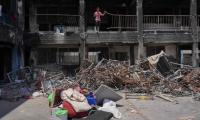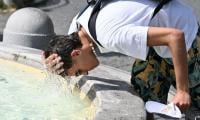Pakistan's success story in defeating terrorism and extremism required consistency in the policy if a decision was really being taken to bring the jihadi outfits into mainstream, changing jihadi narrative formed in the Afghan war. It could be the outcome of the results achieved in operation Zarb-e-Azb, and going into the decisive phase against extremism.
Zarb-e-Azb itself is the continuity of the Swat and Malakand operation and these three operations actually reflect the change in the state narrative in the post-9/11 world scenario. In the last three years in particular, the biggest success came in North Waziristan, which was regarded as the biggest sanctuaries for local and global networks.
The possible new narrative would not be easy; either for the government or the establishment, but the way forward could come through large-scale reforms agenda which includes their rehabilitation, education and jobs.
Following the operation, thousands of foreign and local militants had been killed and Uzbek, Chechen and Afghan alleged terrorists were either killed or flown to Afghanistan and other countries.
It also brought split in many jihadi outfits, but at the same time some new groups also emerged. The biggest damage to them was caused when their accounts were frozen, which led them to earning money through kidnapping for ransom or extortion.
This led to major kidnapping cases like that of Shahbaz Taseer and Ali Haider Gillani, while many Karachi businessmen also faced similar fate, though many stories remained untold.
Thus, the Karachi operation played the major role in checking this trend too, as the commercial hub for years had been among the safest place for 'sleeper cells’, and extortion. Transactions in cases of kidnapping for ransom were made in Dubai.
Crackdown on groups like Lyari gang war and MQM’s alleged militant wing also led to the conclusion that only jidhi outfits or outlawed groups were not involved in such activities but there was also a nexus between 'crime and politics’, through money-laundering.
Therefore, when we looked towards changing narrative of both the successive government and establishment, one found some connectivity and continuity. For the first time, the civil and military leadership have now decided to bring active jihadi groups, including banned outfits, in the mainstream after disarming them.
Late, Emir Jamaat-e-Islami Qazi Hussain Ahmad once told the writer that his party and its affiliated bodies took active part in Jihad-e-Afghanistan because of the state policy but did not send their volunteers when the state changed its policy in 2001, after the US-led coalition attacked Afghanistan.
For instance, in Balochistan and FATA, they are facing problems how to bring those in the mainstream who had laid down arms and surrendered. The government has not given any alternative policy of job quota for such people.
Similarly, so far there is no amnesty policy in Karachi, for those who are ready to surrender, disarm and want to return to their families. The Sindh government and Rangers are working on a ‘Rehabilitation Centre', but so far it is on paper.
In 2001-02, over 13 sectarian and jihadi groups were banned, but because of lose policy, some resurfaced with new names while others merged with each other. However, even under Musharraf, the policy was unclear in differentiating between sectarian, terrorists and jihadi groups.
While Musharraf took hardline against Tehrik-e-Taliban Pakistan, al-Qaeda and foreign militants, it went soft on local networks, which allowed emergence of new groups due to split within these networks and also after their finances were blocked.
Former president General (retired) Pervez Musharraf, on Wednesday, in an interview clearly differentiated between terrorist groups and jihadi outfits. While he put banned Jaish-e-Mohammad (JeM) in the category of terrorist group, he showed soft corner for Lashkar-e-Taiba (LeT) and Jamaatud Dawa (JuD). Interestingly, the LeT, was among the groups banned by Musharraf and as a result JuD leaders claimed they also distance themselves and broke all ties with the LeT.
He even termed the JuD, led by Hafiz Mohammad Saeed, as the best NGO, in the country and praised their work in 2005 earthquake and also during floods.
"We have now decided to concentrate on our social work and welcome the decision of the government to bring jihadi groups into national fold,” JUD spokesman Yahya Mujhaid told the writer on Thursday.
He also welcomed the policy to disarm groups and claimed that the JuD played an important role in defeating Daish narrative in Pakistan. "We led this campaign within our own fold and in the country to counter Daish narrative," he added.
While the JuD is ready to reforms itself and work as a welfare organisation, it is not ready to join the mainstream politics, as ideologically it believes that electoral politics and casting vote are a sin, and un-Islamic.
In the past, religious parties and their alliances approached Hafiz Saeed during 2008 and 2013 elections and tried to convince him to change his viewpoint about electoral politics. Jamaat-e-Islami, Jamiat Ulema-e-Islam and Defence of Pakistan Council, led by Maulana Samiul Haq, also failed in bringing him into mainstream politics.
While the JuD is by and far the biggest group, which not only kept itself away from elections but also imposed restrictions on its followers not to cast votes, there are some other jihadi as well as tableegi groups which don't believe in the present system like Hibut Tehrir, Tableegi Jammat (which only once supported the IJI but had not joined it), Tanzeem-e-Islami, and the banned outfits like TTP or al-Qaeda.
Maulana Sufi Mohammad, leader of Tehrik-e-Nifaz-e-Shariat-e-Mohammadi was the first who completely denounced the Pakistan constitution, Parliament and democracy. He practically had enforced his style of Shariat in his area like the TTP used to do in areas under its control for years.
Jaish-e-Mohammad was formed in high controversial circumstances as a result of further split in the mother party, Harkatul Ansar which, after the first split, became Harkatul Mujhaideen.
Some jihadi outfits including JuD were against the formation of Jaish-e-Mohammad. The then government and the establishment were also not on one page on this issue. In the aftermath of 9/11 and war in Afghanistan, many JeM activists joined the TTP and other more militant groups.
Pervez Musharraf on Wednesday hinted that the JeM was also behind attack on him and said, the group was involved in terrorist activities inside Pakistan and action must be taken against them.
Interestingly, Musharraf, who used the term ‘Non-state actors' hundreds of times during his tenure and defended Kargil, is now trying to confuse the civil and military leadership with his new narrative, the one he himself had abandoned in his tenure.
The connectivity and continuity of Zarb-e-Azb and National Action Plan is the only way forward with some changes in the reforms agenda. But, can we do it? Success of Zarb-e-Azb indicates the state can do it, if they want.
The writer is the senior columnist and analyst of GEO, The News and Jang
College administration is required to appear in person to explain the details of the incident and any actions taken to...
Court observed that the TCP termed it a “shortage”, whereas the Punjab trading agency claims that a substantial...
Anti-Terrorism Special Court Judge Malik Ijaz Asif also announced 32 years in jail and a fine of Rs0.5 million for the...
Two-day conference at the King Abdullah Campus of UAJK aims to chart a course towards sustainable economic growth and...
In Hub, environmental sample was collected on April 17, 2024 from the ‘Jumma Khan Bazar Pul’ environmental sample...
President highlighted that Pakistan was committed to regional connectivity, and the Central Asian countries needed to...







